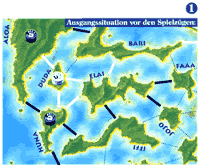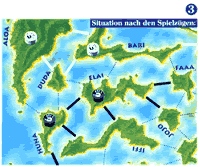English translation by Jay Tummelson
Overview
Two priests, wielders of Kahuna magic, compete to learn who is the more
powerful. They have selected a small group of 12 uninhabited islands and will
use their magical powers to build bridges linking the islands. Each bridge
gives a priest some control over the forces of the islands. When a priest
has built enough bridges linking an island, he claims control over the island
and its vast powers. As the magics and the control of islands shifts, the gods
track the contest, declaring, in the end, who is the most powerful.
Goal
The gods watch for three rounds, keeping track of who controls the islands.
The sum of these scores are tallied to determine which priest is the winner.
Content
| 1 |
|
game board with 12 islands connected by dotted lines representing possible bridges
|
| 50 |
Kahuna magic bridges, 25 each in black and white
|
| 20 |
Kahuna stones, 10 each in black and white |
| 24 |
cards, 2 for each island |

Preparation
- Place the board on a table between the two players.
- Each player takes 25 bridges
and 10 stones of one color.
- One player is chosen as dealer. The dealer shuffles the 24 island cards and
deals 3 to each player face down; these are their starting hands. Each card
bears the name of one of the 12 islands and shows the island in red on a small
map of the archipelago.
- The dealer then turns 3 cards face up next to the board.
- and places the remaining cards in a stack up-side-down next to the board.
- The non-dealer is the starting player and moves first. Afterwards, the players
alternate turns throughout the three rounds.
Playing the game
During a turn a player may play from 0-5 island cards. After playing all the
island cards desired, the player draws one card to add to his hand. A player
may never have more than 5 cards in his hand.
1. Playing island cards
- When a player plays a single card, he places it face-up on the table and
then places a bridge on one of the available dotted connecting lines between the
island on the card and one of its neighbors.
- If the player wants to play several cards, they are played and bridges placed
one at a time.
(exception: removal of opponent's bridge)
- All cards played are placed in a face-up discard pile.
- Instead of playing card(s), a player may discard one or more cards secretly
under the discard pile.
- A player may choose to play no cards in a turn.
2. Control of an island: Kahuna stone placement
- When a player has bridges on more than half of the connecting lines
from an island, he controls that island and may place one of his Kahuna stones
on the island. Note: the cards indicate the number of connecting lines under
the island name.
- When a player gains control of an island, he removes any bridges on that
island belonging to his opponent. If such a removal causes the loss of control on
a neighboring island, the Kahuna stone on the affected island is also removed.
Bridges and stones thus removed are returned to the player who owns them.
3. Removal of opponent's bridge
- A player may play a pair of island cards to remove an opponent's bridge between
two islands.
- The two cards must name only the two islands connected by the bridge to be
removed. For example, the bridge connecting HUNA and ELAI can be removed only
by playing one of the three following pairs of cards: "HUNA - ELAI", "HUNA - HUNA"
or "ELAI - ELAI". The bridge is returned to the owning player.
- The player could then play a card from either island (in the example above:
HUNA or ELAI) to place his bridge between the two islands.
4. Drawing an island card
- After a player has played all cards he desires, which could be none,
he may add one card to his hand,
- taking either one of the three
face-up cards or the top card from the face-down stack. When one of the
three face-up cards is taken, it is replaced by the top card from the
face-down stack.
- However, if a player chooses not to take a card, his opponent
must take a card on his next turn.
- If a player has five cards in his hand and chooses to take a card, he must
first discard one or more cards.
- A player's turn ends when he takes a card or indicates he has chosen
not to take a card.
Scoring between the rounds
- When the last card is taken (from the face-down stack and the three face-up cards)
in the first and second rounds, the players count the number of islands they control
(the number that have Kahuna stones). If the players control the same number of
islands, no points are scored.
- After the first round, the player with the most islands scores 1 point.
- After the second round, the player with the most islands scores 2 points.
- Note the scores on a piece of paper.
- After scoring, shuffle the discard pile, draw three cards and place them
face-up next to the board, and place the remaining cards face-down on the table.
Bridges, Kahuna stones, and cards in the players' hands remain for the next
round.
- Play continues with the player who was next to play when the last card was taken.
Final scoring and game end
When the last card from the face-down deck is taken at the end of the third round
and the last of the face up cards has been taken, each player takes one additional
turn (without taking cards). After those two turns, the islands are scored for the
third and final time. This time the player with the most islands is awarded the
difference in points.
These points are added to those previously earned. The player with the most total
points from the three rounds is the winner. If there is a tie, the player who
scored most in the third round is the winner. If there is still a tie, the player
with the most bridges at the end is the winner. If that does not resolve the tie,
declare the game a draw and play another.
Premature ending
The game ends prematurely, if a player in the second or third round has no
bridges on the board. In this situation, the other player is declared the winner.
Example
The following example shows how within two turns, the control of the
islands can change:
White's turn:

1) White plays BARI and places a bridge between BARI and DUDA, achieving the
majority on BARI and places a white Kahuna stone on BARI. White then removes
the black bridge between BARI and ALOA. Thus, black loses the majority on ALOA
and removes the black Kahuna stone from ALOA.
2) Next white plays ALOA and places a bridge between ALOA and BARI. Thus,
white now has the majority on ALOA and places a white Kahuna stone on ALOA.
White now removes the black bridge between ALOA and HUNA, causing black to
lose control on HUNA. Black must remove the black Kahuna stone from HUNA.
 Black's turn:
Black's turn:

1) Black plays two HUNA cards and removes the white bridge between HUNA and ELAI.
2) Then black plays ELAI and places a bridge between HUNA and ELAI and now
has the majority on both HUNA and ELAI. Black places black Kahuna stones on
HUNA and ELAI. White removes its bridges between HUNA and DUDA, DUDA and ELAI,
and ELAI and BARI. Additionally, white removes its Kahuna stone from DUDA,
having lost majority on that island.

